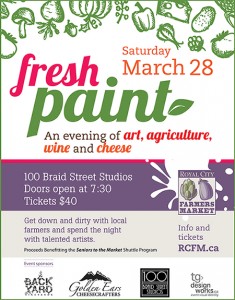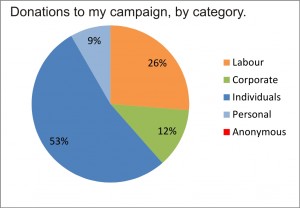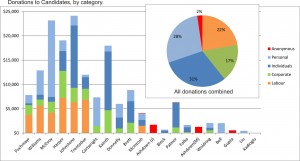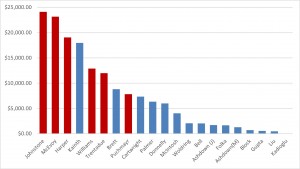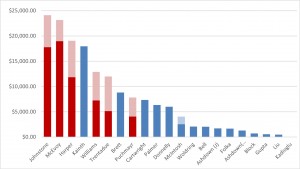I was Acting Mayor last week for a few days, as Mayor Cote took a short vacation. As such, I got to enjoy media attention around the “Rescue Our Parkade” issue. This Meeting of Council included several delegations around that issue, so I guess I will need to write another blog post about that. The main decisions around the Parkade were already made months ago, so I will save this blog post for writing about the issues on our agenda.
We had a few announcements (interesting procedural note than one cannot both provide a Presentation and Chair the meeting, so The Mayor relinquished the Chair role to me as Acting Mayor, which caused general hilarity all around). After announcements and delegations, we started the meeting with an Opportunity to be Heard:
Development Variance Permit – 111 Wood Street
There were no delegations and no correspondence received on this Permit application, which was to develop a set of Townhouses in the southern part of Queensborough. This construction aligns with the adjacent developments, fills a bit of a gap on the South Dyke and obviously raised no hackles in the neighbourhood. We moved to issue the Development Variance Permit and the Development Permit.
We then moved on to Recommendations from the Committee of the Whole meeting of March 9, 2015:
YVR Request
Representatives of Vancouver International Airport sent us a letter requesting an opportunity to meet council and discuss their plans and visions for their operation and impacts on the Region. Council moved to formally invite them to our May 11th Council Meeting.
ICBC Representative to ACTBiPed
We formally approved the naming of the representative from ICBC to the Advisory committee for Transit Bicycles and Pedestrians. Welcome to the team (officially) Karon!
We then moved on to Recommendations from the Committee of the Whole meeting of March 23, 2015:
KUDOZ – A City of Learning
We had a great presentation during the Committee of the Whole meeting from an organization that is working to get people who have employment or other social barriers into learning experiences throughout the City. We were happy as a council to endorse the project. If you want to make a meaningful change in someone’s life but just sharing an hour of your everyday work or volunteer life, you should definitely check out Kudoz at this link!
Amendment of Council Schedule
Legislative Services wants to adjust our schedule to accommodate a few larger projects that are coming to Public Hearing. Although Public Hearings typically happen at the last meeting of the month, the April Hearing looked to have a couple of high-profile projects, and staff are concerned that people’s ability to be heard will be limited by the schedule. They first suggested holding a second Public hearing on April 20, but the project proponent did not like the shortening of their schedule while they are still doing public outreach, and trying to address some concerns. Therefore, we have added a May 4 Public Hearing date. Mark your calendars!
Nomination to the FCM
Councillor Williams was unanimously nominated by Council to represent Mayor and Council at the Federation of Canadian Municipalities for 2015.
318 and 328 Agnes Street
There is a proposal to put two new dedicated rental housing buildings on the old school property and empty lot 314 Agnes Street (kitty-corner from Qayqayt School). We moved agreement with the principles of the Housing Agreement, then the required Zoning Amendment passed first and second reading, and I will hold off on offering comment as this will go to Public Hearing on April 27, 2015. Come on out and tell us what you think.
26 East Royal Ave (Victoria Hill Parcel E)
This is one of the final pieces in the Victoria Hill neighbourhood development. This building will bring a bit of ground-based retail to provide some basic services to the Victoria Hill neighbourhood for the first time. This site has seen significant review since 2012, and the current design (two 4-story buildings with a walkway between them, mostly 2- and 3-bedroom units and 113 parking spots for 64 units) definitely reflects earlier concerns expressed about the earlier plans. This is a preliminary report, as the development will be going out to community consultation, design panel, etc.
Sewerage and Drainage Regulation Bylaw
Staff is also updating the Bylaw that regulates the City’s sewer systems. I deal with these types of bylaws in my regular working life, so I went through this with more interest than is strictly healthy. The good news is that I do support it.
An interesting note related to this bylaw and the provisions for source separation. The City of New Westminster is encumbered by a very old sewer system, a legacy of our being a 150 year old City, and a lack of infrastructure investments in the second half of the 20th Century – we have a lot of catching up to do. We have 70 km of storm drainage lines (21km in closed storm sewers, 49km in open watercourses – or “ditches” as they like to call them in Queensborough). We also have 33 km of sanitary sewers, all relatively new. The problem is the 150km of “combined flow” sewers. These are sewers that collect sanitary waste from houses and businesses, but also collect storm water from roof leaders and roadways.
The problem with “combined flow” sewers is that they have to be treated at the end of the pipe like sewage (because of all the nasty stuff we flush). When it rains, there is a huge volume of water that enters the system and is mixed with that sewage, causing us to have to treat it all. The sewer treatment plants in Metro Vancouver don’t like this – it costs them a lot of money to treat all of that volume (and they pass that cost on to us). Environment Canada doesn’t like it either, because occasional very large rains can overwhelm the system and allow some untreated sewage to enter the River.
The City has a decades-long plan to separate the City’s remaining combined-flow sewers, and we are putting some of your annual sewer bill away in a reserve fund to use for this work when it makes sense to dig up a road. However, separation also had to happen at the source. Many residences (like mine) have a single “out” pipe that directs relatively clean roof leader and perimeter drainage water to the same place as that decidedly unclean sanitary outflow goes. If the City wants to separate the systems, then homeowners are going to need to separate their systems as well. Doing the necessary in-ground work to install two pipes and an inspection chamber on residential properties is costly 9up to $10,000, which can be a surprise to homeowners who just want to repair their perimeter drains. The City takes a long view on this, and is not forcing people to do this work until they are performing major renovations, building new structures, or actually repairing the outflow pipes on their property.
Yeah, I probably care too much about sewers.
Statutory Right of Way for FortisBC
Fortis want so provide utility service to supply utility service to a development in Victoria Hill. Not much to discuss here.
Energy Save New West
New Westminster has an energy save program that is pretty cutting-edge. The report received shows they are meeting and exceeding their targets. You should go to their fancy new web site and see how they can help you save money on energy use for your home or business in New Westminster, and help you get rebates for the cost of those energy saving renovations. It’s good stuff.
Do I show my age by even using the phrase “fancy new web site”?
2014 Election – Disqualification of Candidates
A couple of candidates in the recent Municipal election failed to file financial disclosure statements. That’s against the law. There are penalties under the Act, including big fines, but that is the province’s problem. The part the City is responsible for enforcing is a one-election ban from running for local office again. Remember, these candidates are not in trouble for filing false or incomplete declarations, but for not putting anything at all in. They could have downloaded the form, left it blank and signed it, and they could have avoided this (at least until the review of the declarations is completed by ElectionsBC). The issue that one of these two candidates clearly shared advertising with a couple of people who were successfully elected, and those people did not disclose any such shared expenses, is also something I suspect ElectionsBC will deal with when they start reviewing the declarations.
This is separate from the concerns raised by Council around some of the concerns about polling stations last election. It seemed there were one or two polling booths that were not well organized and had long line-ups, some machines that did not work, and a few procedural and/or logistical problems around people needing assistance at the polling station, such as language interpreters. We have asked that there be a report brought to council to review what went right or wrong during the election, so we can do a better job in 4 years.
410 Columbia Street Upgrades
The building on the south side of Columbia at 4th is an eyesore. The owner is going to renovate and reduce the soreness. This is a good thing. I kind of hope it waits until after May 2, as there are some ugly, but interesting, rocks attached to the old façade.
Family Friendly Housing Policy
The City has been working on a policy to assure a supply of family-friendly housing. I wrote a bit about this previously, as we did some work-shopping on the topic. Council decided to endorse the recommendations in the staff report and take the Bylaw to Public Hearing on May 25, 2015. C’mon out and tell us what you think.
We received some correspondence.
The one from the Ministry of Transportation rather irritated a few members of Council. At some point, people are going to start to think that the Minister wants the Metro Vancouver Transportation and Transit Plebiscite to fail. I’m not saying that, because that would suggest he wasn’t being honest when he repeatedly said that he supports the YES side. But I cannot square that with the idea that the week we receive our ballots to decide if we will ask the Province to please allow us to invest $750 Million a year of combined Local, Provincial and Federal money to keep our struggling transportation system operating the right time for the Minister to announce he will be spending $2.5 Billion over three years to build bridges and pave highways and buy busses for everywhere in the Province except the Lower Mainland. You are paying for all of that $2.5 Billion, you are not allowed to vote on it, nor will you be allowed to vote on a similar amount spent on a Massey Tunnel replacement, just as you didn’t vote on a Port Mann bridge that is now $3.6 Billion in debt. Yeah, this is a rant, but as local leaders are busting their asses trying to get the word out that we need a little transportation funding here, he is taking a “hands off” approach while handing money over to Kamloops and Kelowna and Chilliwack. So yeah, that letter arrived at a sensitive time.
And that’s all I have to say about that, except maybe Vote Yes: at least that way some of your taxes will go to building something near where you travel every day.
Bylaws:
The Electrical Utility Amendment Bylaw which saw three readings on March 2, 2015 was adopted – it is now the Law of the Land.
Zoning Amendment Bylaw 7740 (318 and 328 Agnes Street) as discussed above, had two readings, and will go to Public Hearing on April 27, 2015.
Zoning Amendment Bylaw 7741 (Family Friendly Housing) received two readings, and will go to Public Hearing on May 25, 2015.
Sewerage and Drainage Regulation Bylaw No. 7746, as discussed above, received three readings.
And after a few Notices of Motion which will be discussed later, we were done for the evening.
Big important notice: The March 30th Meeting of Council will include a Public Hearing at 6:00pm. At 7:00pm, we will have an opportunity for Public Comment on the Draft 2015-2019 Financial Plan for the City. That’s usually a good one. Background info here.
